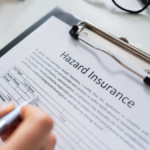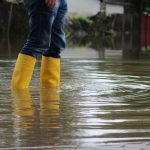Flooding is one of the most common natural disasters in the country, making it a potential threat to nearly every homeowner. You don’t need to live in coastal states like Florida or Louisiana to experience flooding. Heavy snowmelt, intense rainfall, and even unexpected weather patterns can lead to flooding in states as varied as Utah, Colorado, and those in the northern regions.
Given the likelihood of flooding, it’s crucial to ensure your property is protected. But what exactly is flood insurance, and why isn’t it included in most homeowners’ policies? Keep reading to find answers to these questions and more about safeguarding your home from flood damage.
What is flood insurance?
Flood insurance is a specialized form of insurance coverage designed to shield property owners from the financial repercussions of flood-related damages. Unlike typical homeowners or business insurance policies, which often exclude coverage for flood damage, flood insurance is available to step in to provide specific protection against losses incurred due to flooding events.
Flooding an increasingly tricky topic because it is more prevalent than ever, and homes and businesses that wouldn’t have been at risk of flooding decades ago are—or may soon be—in the path of rising waters. That’s bad news, as restoring flood-damaged homes and businesses with personal finances can be devastating for many Americans.
According to FEMA, out-of-pocket expenses for flood damage and repairs can be costly — even for owners who have taken out flood insurance policies. In the U.S., on average, flood insurance claimants currently pay nearly $7,500 in restorative expenses, while their insurance payouts average nearly $40,000. Additionally, about ⅕ of policyholders need to borrow money to pay their share of damages and repairs. These steep out-of-pocket costs and rising flood insurance premiums may force some policyholders to question whether they really need coverage.
The Importance of Flood Insurance
Flood insurance is crucial for protecting your property, regardless of where you live. Floods can occur anywhere, even in areas with low to moderate risk. Surprisingly, nearly 25% of flood insurance claims come from these areas. It’s essential to check your flood zone online to assess your risk. If you’re in a high-risk zone, your mortgage lender will likely require you to have flood insurance.
A severe flood can cause catastrophic damage, sometimes leading to the total loss of your property. Without proper flood insurance, you could face overwhelming financial challenges. Ensuring you have the right coverage is vital to safeguarding your home, business, and belongings.
Guided Solutions understands flood risk mitigation
At Guided Solutions, we know flood insurance inside out and are here to help you every step of the way. Our experienced agents will work with you to determine your property’s flood risk and find the best coverage that fits your needs perfectly.
We’ll walk you through all the different flood insurance options available, whether from the National Flood Insurance Program (NFIP) or private insurers. Our goal is to ensure that you fully understand exactly what’s covered and what’s not and how to get the right protection for total peace of mind.
Here are six questions we typically address when speaking to prospective flood insurance policyholders:
1 – Does flood insurance conflict with my other policies, like homeowners or business insurance?
Flood insurance typically complements other insurance policies, such as homeowners or business insurance, rather than conflicting with them. However, homeowners and business insurance policies usually don’t cover flood damage, so a separate flood insurance policy is needed to protect against specific flood-related losses.
It’s always a good idea to consult with your insurance agent or provider to clarify any questions or concerns you may have about how your various insurance policies interact. You’ll want to check to see if there are any overlaps in coverage, whether you need separate policies for different types of water damage, and how filing a claim for flood damage might affect other insurance premiums.
2 – What are the consequences of not having flood insurance?
Not having flood insurance means you’re on the hook for any damage caused by flooding, which can be seriously expensive. You’d have to pay for repairs and replacements, which can add up quickly if you’re the victim of a big flood.
Additionally, if you have a mortgage on your property and it’s located in a high-risk flood zone, your lender may require you to have flood insurance. Failure to maintain this coverage could lead to penalties or even foreclosure.
3 – What’s not included in flood insurance coverage?
You’ll want to carefully review your flood insurance policy and discuss any concerns with your insurance provider to understand the specific exclusions and limitations that apply to flood coverage in your area. Based on your circumstances, you may want to consider whether you need additional coverage or insurance endorsements to fill any gaps in protection.
Some standard exclusions and limitations in flood insurance policies include:
- Coverage Limits: Most flood insurance policies have coverage limits for both building property (e.g., your home or business structure) and personal property (e.g., belongings). These limits may not fully cover the cost of rebuilding or replacing everything damaged in a flood.
- Basement Coverage: Coverage for basements and areas below ground level may be limited. Items like finished basements, carpeting, and personal belongings stored in basements might not be fully covered or even covered at all.
- Temporary Living Expenses: Flood insurance typically doesn’t cover temporary living expenses if you’re displaced from your home due to flooding. You may need additional coverage for this through a separate policy, such as a homeowners policy.
- External Property: Some items outside your home, such as landscaping, decks, fences, and swimming pools, may have limited coverage or be excluded altogether from flood insurance coverage.
- Gradual Damage: Flood insurance usually covers sudden and accidental flooding but may not cover damage caused by gradual water seepage over time.
- Business Interruption: Flood insurance typically doesn’t cover financial losses due to business interruption caused by flooding. You may need separate business interruption insurance for this coverage.
4 – How much are flood insurance premiums?
The price you pay for flood insurance depends on various factors. Here are the main ones that influence your monthly premiums:
- Flood Zone: Properties in high-risk flood zones, such as Special Flood Hazard Areas (SFHAs), typically have higher premiums than properties in low—to moderate-risk zones.
- Base Flood Elevation (BFE): The elevation at which there’s a 1% chance of flooding in any given year (often referred to as the “100-year floodplain”). Properties below the BFE may have higher premiums.
- Property Characteristics: Factors such as your property’s age, construction type, and elevation can affect your premium. Properties with flood-resistant features, such as elevation above the BFE or flood vents, may qualify for lower rates.
- Coverage Amount: The amount of coverage you select for your building and contents will impact your premium. Choosing higher coverage limits will result in higher premiums.
- Deductible: The deductible is the amount you’re responsible for paying before your insurance coverage kicks in. Opting for a higher deductible can lower your premium, but it means you’ll pay more out of pocket in the event of a claim.
- Flood History: Your area’s flood history, including past flood events and claims, can influence premium rates.
- Flood Insurance Program Changes: Premium rates can be affected by changes in the National Flood Insurance Program (NFIP) regulations, such as rate adjustments mandated by legislation or updates to flood maps.
- Subsidized vs. Actuarial Rates: Some properties may qualify for subsidized rates, which are lower than actuarial rates. However, subsidized rates may be phased out over time, leading to higher premiums.
5 – Can I try to lower my flood insurance premiums?
To reduce flood risk and possibly lower your flood insurance premiums, consider taking these steps:
- Elevation: Raise your home or essential utilities (like water heaters and HVAC systems) above the Base Flood Elevation level to reduce the risk of flood damage. It might qualify you for lower insurance rates.
- Maintain Drainage Systems: Keep your gutters, downspouts, and drainage systems clear of debris to ensure proper water flow away from your property.
- Floodproofing: Invest in installing flood barriers, sealing walls and foundations, and using water-resistant materials to minimize structural damage.
- Install Sump Pumps: Equip your property with sump pumps featuring battery backups to remove water from basements or crawl spaces automatically.
- Flood Insurance Policy Review: At least once a year, review your flood insurance policy with your provider to ensure you have adequate coverage based on any changes in your property or flood risk.
6 – What is the flood insurance claims process like?
The claims process for flood insurance usually starts with documenting the damage. You’ll want to take photos or videos of the flooded areas and any damaged belongings as soon as it’s safe to do so. Then, you’ll need to contact your insurance company to file a claim. They’ll guide you through the process and may send an adjuster to assess the damage in person.
Once your claim is filed, the insurance company will review it and determine the coverage and payout amount based on your policy. Try to provide as much information and documentation as possible to support your claim and keep the process from slowing down. The more the insurance company has to ask for things you could have provided early on, the longer the process takes.
After the claim is approved, you’ll receive payment to cover some or all of the cost of repairs, replacements, or other covered expenses. Keep in mind that there may be deductibles and coverage limits outlined in your policy.
Throughout the process, your insurance company should keep you updated on the status of your claim and answer any questions you have along the way. If you experience difficulties or delays, don’t hesitate to reach out to your insurance agent or provider for assistance.
Taking Proactive Measures Today
Floods are serious business. You should be aware that flood insurance providers may deny coverage for high-risk locations, insufficient documentation, policy limitations, not following floodplain rules, lapses in coverage, giving wrong information, or being ineligible for federal help. If coverage is denied, ask your insurance agent or local authorities for help.
Remember, delaying action until a flood strikes can be disastrous. The first step to keeping your property safe from flood damage is getting the right insurance. Call us today at (833) 791-4719 to find out more about flood insurance. You can also use our online app, and we’ll help you find the perfect flood insurance policy. Click here to get a quote.










